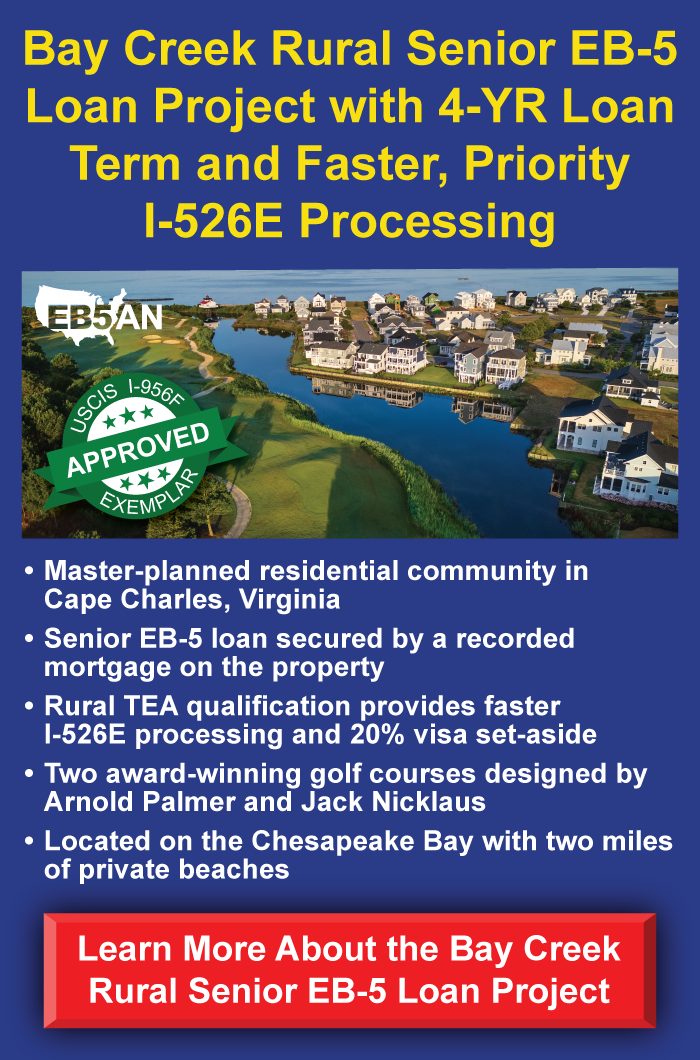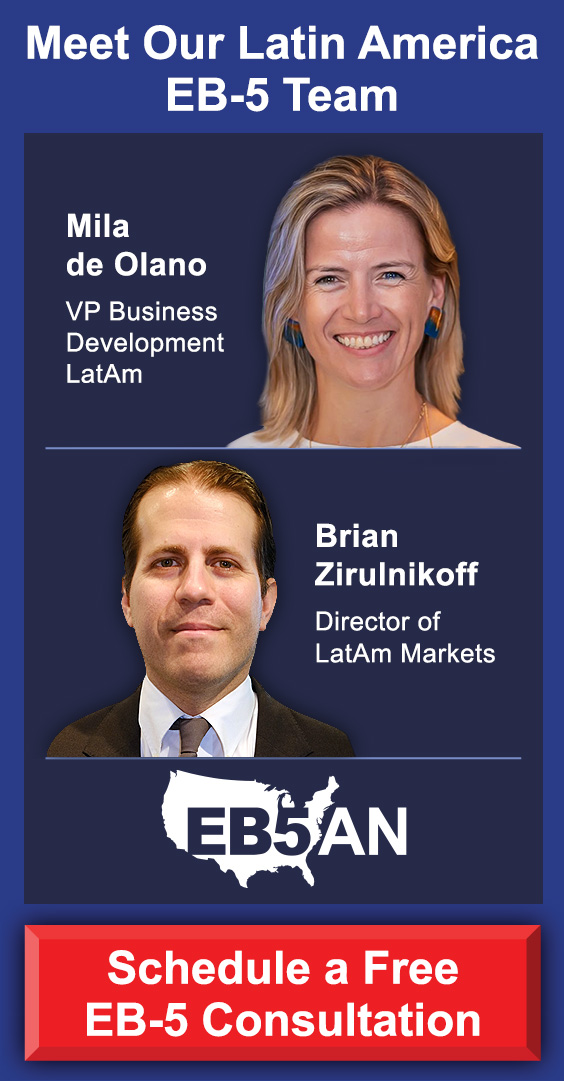If you are considering an EB-5 visa investment, your goal is to become a permanent resident of the United States. The EB-5 program is a rare direct path to a U.S. Green Card, and you could receive yours in a matter of months after applying.
However, immigration is just one aspect of making an EB-5 investment.
You will also want to recover your funds. With a minimum amount of $800,000, an EB-5 Green Card requires a substantial investment. The EB-5 program does not guarantee that you will recover your capital.
If you choose your EB-5 project carefully, you could receive a full repayment with interest, like other successful EB-5 investors. But if your EB-5 project fails, you could also lose every cent of your $800,000 investment.
Your chances of receiving a timely return on your funds depend on your EB-5 project’s financial performance and the terms of the EB-5 investment—especially the redeployment terms.
Since USCIS updated the requirements for EB-5 redeployment in 2023, this policy has become increasingly relevant for the financial safety of EB-5 investors.
Essentially, USCIS requires your EB-5 funds to remain invested and at-risk for a specified period. But depending on the terms of your EB-5 investment, your EB-5 project may be ready to repay your funds before the minimum USCIS period has been reached. In this case, the funds would have to be redeployed (that is, reinvested) into another EB-5 project.
If redeployment is not handled carefully, it can result in your funds being invested in a high-risk project that could fail financially. Two situations can make EB-5 redeployment particularly risky:
1. The EB-5 lender and borrower are controlled by the same party or otherwise affiliated.
2. The EB-5 project stands to profit from any future redeployment of your funds.
“Redeployment can put your EB-5 funds at high risk,” cautions Sam Silverman, managing partner of EB5AN. “With some uncertainty about USCIS’s future policies for redeployment, we advise investors to carefully study the redeployment terms before subscribing to a project.”
In this post, we explain how to identify these high-risk situations in an EB-5 offering.
First, let’s consider why redeployment can be necessary in an EB-5 offering.
When is EB-5 Redeployment Necessary?
Scenario 1: EB-5 Lender and Borrower Are Related or Controlled by the Same Parties
- Can “Vertical Integration” Benefit EB-5 Investors?
- A Real-Life Example of Borrower-Lender Conflict of Interest
Scenario 2: The Original EB-5 Borrower Stands to Profit From Redeployment
How to Avoid a High-Risk Redeployment and Protect Your Funds
Further Reading
When is EB-5 Redeployment Necessary?
The following describes the flow of EB-5 funds from EB-5 investor to EB-5 project, and back.
An EB-5 investor wires the $800,000 to the regional center’s escrow account. According to the investment terms, the funds are then released into an investment fund set up by the regional center. This investment fund functions as the EB-5 lender.
The EB-5 lender then loans the funds to the EB-5 project developer entity. The developer entity acts as the EB-5 borrower.
Following the terms of the EB-5 loan, the borrower should repay the loan at maturity to the lender. The lender can then repay each EB-5 investor along with any interest.
However, recall that USCIS requires the EB-5 funds to remain invested, or at-risk, for a specified period. Under the latest policy guidance, EB-5 funds must remain at-risk for a minimum of two years starting from the time of investment.
What happens if the EB-5 borrower repays the lender before the investors’ funds have been invested for a minimum of two years?
In this scenario, the EB-5 investors are not allowed to be repaid. This would disqualify them from obtaining U.S. Green Cards.
Instead, the EB-5 lender would have to redeploy the funds into a second EB-5 project until the two-year investment period has been reached.
Redeployment often adds an additional layer of risk to an EB-5 offering. Even if you invest in a financially sound EB-5 project, your redeployed funds may end up in a second, riskier project.
Let’s now consider two scenarios that can make redeployment especially risky and endanger your invested funds.
Scenario 1: EB-5 Lender and Borrower Are Related or Controlled by the Same Parties
In some EB-5 offerings, the EB-5 lender (the regional center’s investment fund) and the borrower (the project developer) may be related. Both entities may be controlled by the same parties or otherwise affiliated. The regional center may be directly owned or beholden to the developer.
Indicators of this clear conflict of interest include regional centers and developers that share the same name or have the same principals.
In this situation, the EB-5 borrower will essentially be lending your invested funds to itself. This may not pose a problem as long as the EB-5 project succeeds financially and your funds do not need to be redeployed.
But most likely, the EB-5 borrower will act in its own best interests and significantly delay the repayment of your EB-5 fund—or, if the project stalls financially, you may lose every cent of your investment.
The borrower may place the EB-5 funds at the lowest priority of its capital structure. If the project fails to generate enough revenue, there may not be enough funds to repay the EB-5 loan.
The borrower may also alter the loan terms to be more favorable for themselves in order to make payments. Or it could change interest rates, potentially resulting in a significantly lower return on investment.
The lender may also redeploy your funds into a risky second project only because it promises high returns. Or the lender could choose a second project with a long investment period, significantly delaying your repayment.
For any investor, a situation like the one presented above is undesirable. For EB-5 investors, however, a project’s financial failure may also affect EB-5 job creation. Each EB-5 investor must create at least 10 new full-time U.S. jobs through his or her investment. Failure to do so will disqualify an investor from receiving a permanent U.S. Green Card—not to mention losing his funds.
By contrast, when EB-5 lenders remain independent of the borrower, they are not subject to such conflicts. Independent regional centers are much more likely to serve their EB-5 investors’ interests.
If financial difficulties arise, an EB-5 lender may force the developer to sell other assets to repay EB-5 investors in a timely manner. An EB-5 lender can also negotiate on behalf of its EB-5 investors to ensure sufficient job creation takes place.
Can “Vertical Integration” Benefit EB-5 Investors?
Some EB-5 firms claim that having the lender and the EB-5 borrower under one roof gives investors a tighter grip on the project, since “we control everything from top to bottom.” That argument falls apart when you realize independence is exactly what protects your capital. With the same group running the fund and the project, there’s no separate entity to press for your interests if financial difficulties arise.
Vertical integration helps the developer shave costs and boost profits, but it doesn’t make you safer. When the EB-5 lender answers only to the developer, they can steer your $800,000 wherever it suits the project’s cash flow—changing loan terms, delaying repayment, or pocketing fees without scrutiny. You lose the checks and balances that an outside fund manager would provide.
If redeployment becomes necessary, the same party will decide where to drop your capital next. They might push it into a high-fee, high-risk deal that promises bigger returns for them, not for you.
What should be a safety net—a fresh project vetted by an independent team—becomes a profit engine for the developer, with your funds on the line.
A Real-Life Example of Borrower-Lender Conflict of Interest
The Palm Beach Post reports on the consequences of such conflicts of interest in the Harbourside Place EB-5 project. Over 80 EB-5 investors sued the project for fraud. In this development, the EB-5 borrower and lender were controlled by the same party.
The investors in this project claim that the borrower/lender “structured the deal to eliminate them as a first-priority lender and instead convert their investment into equity, [and] positioned the project so he could control ‘every aspect’ of the EB-5 investors’ money, and use the money free of any independent oversight or accountability.”
In short, the investors claim that the borrower/lender “structured the deal in such a way as to eliminate their ability to get their money back,” in a “carefully planned fraud designed to yield [the developer] unfettered access to their money to finance his project.”
Read the full story here.
Scenario 2: The Original EB-5 Borrower Stands to Profit From Redeployment
This arrangement is less common than Scenario 1 and even riskier for EB-5 investors.
The EB-5 loan agreement may state that, in the case of redeployment, the original EB-5 borrower will share in any profits gained from that redeployment. The original borrower may also have the option to prepay the EB-5 loan to the lender—before the investment period is over—without penalty.
This makes it easy for the EB-5 lender and the original borrower to conspire together and maximize their profits at the expense of the EB-5 investors.
The original borrower would be inclined to repay the EB-5 loan early, thus forcing the need for redeployment. The EB-5 lender could then redeploy the funds into a second, high-risk EB-5 project that promises high returns—then share the profits with the original borrower.
Both the EB-5 lender and the borrower would have a financial incentive to redeploy your funds into a high-risk EB-5 project. Despite what an EB-5 project may claim, these risky redeployment terms can have absolutely no benefit for EB-5 investors—they simply increase your risk.
Why would an EB-5 project agree to share redeployment profits with the borrower?
EB-5 lenders can be desperate to work with a particular EB-5 project if it offers higher returns or seems appealing for investors at face value. EB-5 brokers may be eager to promote such a project if they fail to read the offering document carefully.
In contrast, a reputable EB-5 lender will choose its projects selectively. The borrower should have a clear incentive to use the EB-5 funds throughout the full investment term instead of making an early repayment—once the funds are repaid to the lender, the borrower will no longer benefit from the capital.
Even if the funds have to be redeployed after the borrower repays them, the borrower will not share in any future profits.
In this example, the probability of a high-risk redeployment is significantly lower.
How to Avoid a High-Risk Redeployment and Protect Your Funds
How can you identify EB-5 projects with these risky redeployment terms?
The EB-5 Reform and Integrity Act of 2022 requires EB-5 projects to disclose in their offering documents any conflict of interest between the EB-5 lender and borrower. Such disclosures are also required in project and regional center Form I-956 filings.
Before investing, carefully study an EB-5 project’s offering documents to identify conflicts of interest like the ones described in this article. The EB-5 lender and borrower should be fully independent. And the borrower should have no financial incentives to force redeployment.
If you find a conflict of interest in a project’s offering documents, avoid investing in that project. And if it’s unclear whether a conflict of interest exists, ask the regional center in writing.
If an EB-5 offering has a conflict of interest but fails to disclose it clearly in the offering documents, the regional center has failed its fiduciary responsibility toward its investors and is likely noncompliant with the RIA.
USCIS can now fine non-compliant regional centers up to 10% of raised capital. Non-compliant regional centers may even face termination. The measures set forth in the RIA make regional center qualifications an even more essential consideration for EB-5 investors. Regional centers acting as fund managers with conflicts of interest increase the risk of noncompliance. That risk directly transfers to investors.
“Redeployment can add another layer of uncertainty for EB-5 investors,” observes Silverman. “Ideally, an EB-5 project will use the EB-5 funds for the full investment term, create the required number of jobs, and repay the capital without the need for redeployment.”
“With an ongoing lawsuit against USCIS regarding their redeployment policy, we encourage EB-5 investors to pay close attention to the risk factors described in this article. By studying the offering documents before investing, you can avoid losing all or part of your $800,000 investment.”
For personalized guidance on making a safe EB-5 investment, schedule a free consultation with EB5AN.
Further Reading
Forbes Article by Sam Silverman: Navigating EB-5 Redeployment: Medium-Duration Rural Projects As The Best Strategy To Mitigate Risks







